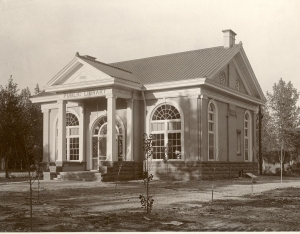
Carnegie Library in 1901 on the corner of 7th and Grand
1897 | 1900-1920 | 1921-1939 | 1940-1966 | 1967-1969 | 1970-1989 | 1990-1999 | 2000-2009 | 2010 to 2019 | 2020 to Present Day
1897
Public libraries in Western towns were almost always started by women citizens anxious to provide culture for themselves and their families. This was certainly true of the first library in Grand Junction. While it is not known what became of Grand Junction’s first attempt to organize a public library (a meeting of the Grand Junction Library Association in January 1883), we do know that an effort in 1897 was successful. When Grand Junction was sixteen years old, members of two women’s clubs united as the Women’s Library Association with the goal to establish a free public library. The first step toward this goal was taken in 1898 when the association opened a subscription library to “anyone whose morals were unquestionably good.”
1900-1920
By 1900, the association had received a promise from Andrew Carnegie to donate $5,000 for a library building, with the usual stipulation that funds be secured for the on-going support and maintenance of the library. The ladies lobbied the city council and, in due course, members of the council pledged $1,200 a year to support a library. A site was chosen on the corner of 7th and Grand, and the grand opening of the Grand Junction Public Library (GJPL) was held on July 5, 1901. The Women’s Library Association turned over its books and property to the public library, and the members promptly voted the association out of existence.
1921-1939
The Grand Junction Public Library developed steadily, and the citizens of Grand Junction were well-served. Residents of Mesa County who lived outside of the city limits, however, were charged a fee for services. Interestingly, the records show that GJPL operated a branch library in the Riverside School and gave free library service to the Redlands area from 1923 to 1938. In the 1930s, the main library outgrew the Carnegie building. In 1938, federal Public Works Administration funds were used to construct a new building on the corner of 5th and White. The library remained in this building for the next thirty-six years.
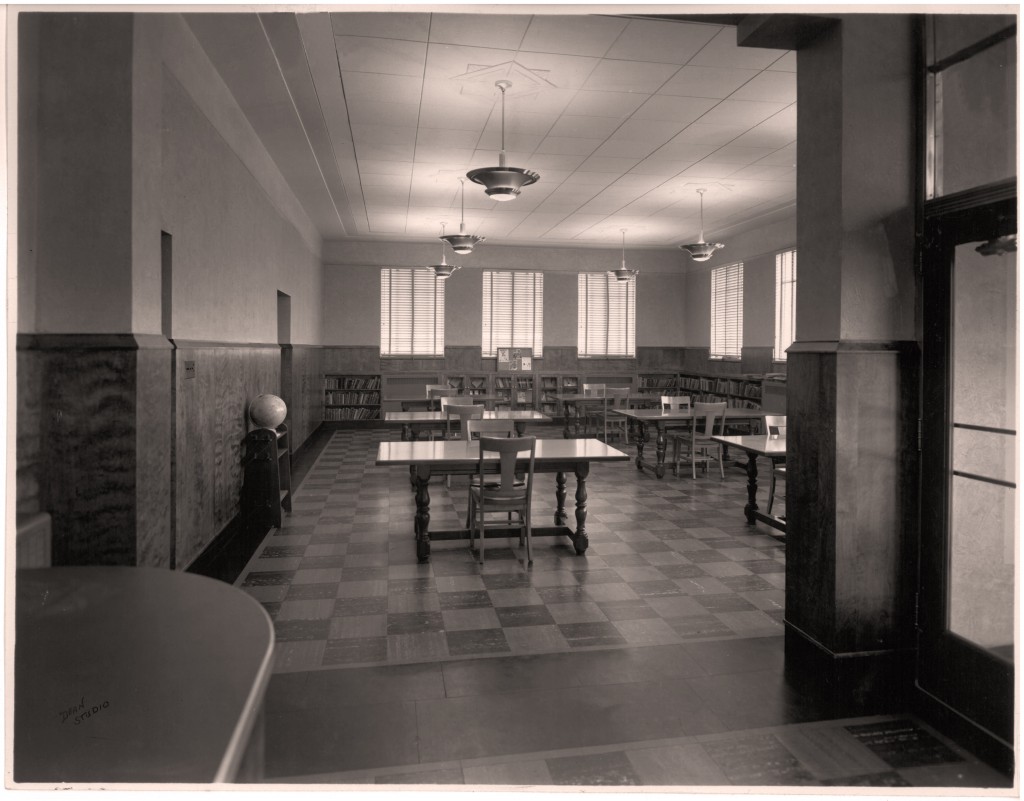
Interior of Grand Junction Public Library at 5th and White
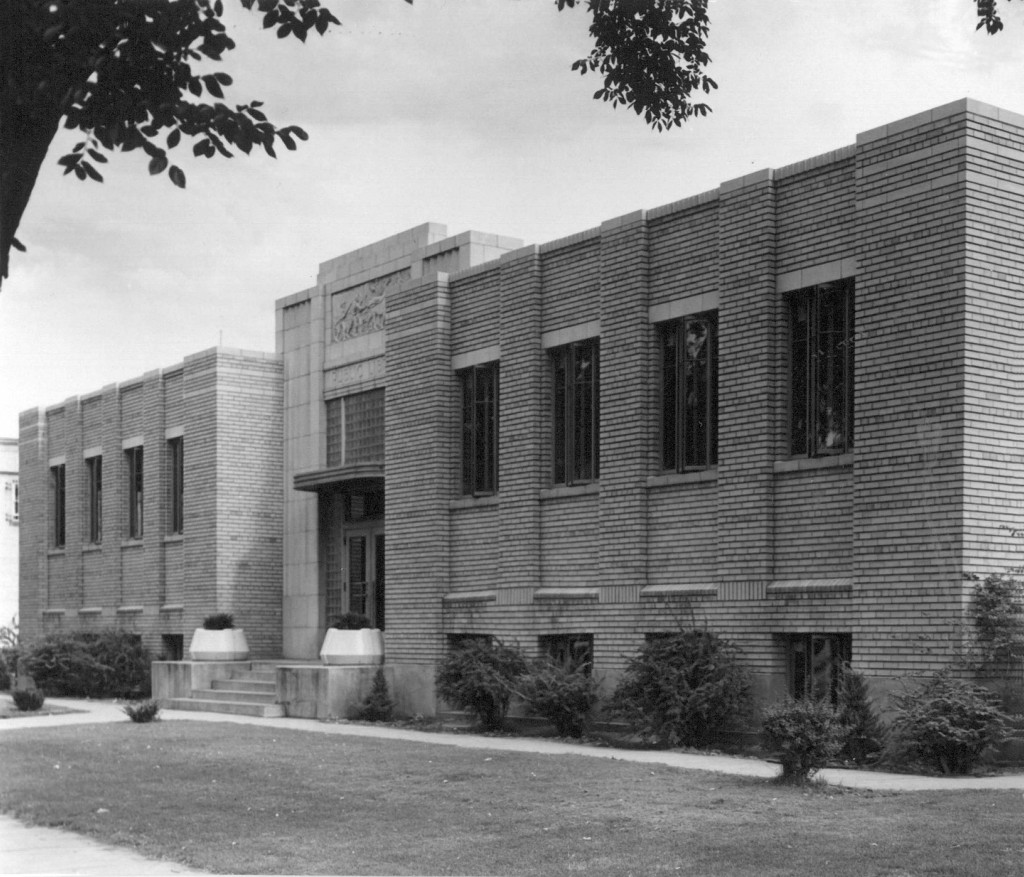
Grand Junction Public Library on the corner of 5th and White
By the late 1930s, several agencies in Mesa County were attempting to find a way to provide free public library service to rural citizens of Mesa County. In 1936, the National Youth Administration (NYA), Mesa County, and local school districts worked together to staff reading rooms in Appleton, De Beque, Glade Park, Hunter, Loma, Pear Park, and Purdy Mesa. In 1940, a statewide rural library system organized by Mesa College Librarian Lillian Sabin, under the auspices of the Works Progress Administration (WPA), established an office in Grand Junction. That same year, the NYA and WPA library systems merged to form a single countywide system under the WPA. The Mesa County Public Library (MCPL) circulated books from Grand Junction’s Community Services building at 220 North 5th.
During this period, women in Collbran and Palisade took it upon themselves to provide library services for their communities. In 1920, women meeting in a Collbran “study club” established an all-volunteer public library. The library operated out of the Independent Order of Odd Fellows Hall from 1920 to 1922. In 1922, the library moved to the Congregational Church Community House at 104 Elm Avenue.
Also in the 1920’s, a group of Palisade women ordered books from the State Library and dispensed them from the homes of members. In 1934, they were able to open a permanent library in a building next to the pool hall on Main Street. The library moved into a city-owned building on Second Street in 1936.
1940-1966
Funding from the WPA ended in 1942. At this time, the Mesa County Public Library would have been forced to close except that a new and possibly unique way to operate the library was arranged. Mesa Junior College had some money remaining from a Navy contract and, with those funds, it took over the financing and administration of MCPL.
During a period of growth in the county from 1951 to 1959, community libraries began in Clifton, De Beque, and Fruita (which was operating at 302 E. Aspen Avenue by 1965). At first, these libraries operated independently but received bulk loans of books from MCPL. When financing and administration stabilized, MCPL took over their operation and also operated a branch in Gateway. At one point, it even operated a branch in Rangely which, although not in Mesa County, was part of the Mesa Junior College District.
The town libraries in Palisade and Collbran continued to operate independently, although they also received long-term loans of books from MCPL. In 1953, The Palisade Library left its location on Second Street after seventeen years, moving into the Bower Garage at 208 East Third Street.
Between 1940 and 1959, MCPL’s Grand Junction branch moved twice. At the library’s 616 North Avenue location, service continued to expand to schools and the community, even within incredibly cramped quarters.
Services also continued to expand at the Grand Junction Public Library. In 1963, the library became the headquarters of the Western Slope Demonstration Project. This project was a predecessor of today’s interlibrary loan service. Each day, public libraries from all over the Western Slope would phone GJPL at a designated time with their interlibrary loan requests. Those requests that could not be filled at GJPL were sent by teletype to the Bibliographic Center in Denver.
Bookmobile service was added in 1941.
A major component of MCPL’s service was to all the schools in Districts 49, 50, and 51. It was a rare classroom that did not have a customized collection of books for student use.
1967-1969
Much happened during these few years, including the consolidation of the Grand Junction Public Library and the Mesa County Public Library under the auspices of MCPL. During the 1950s and 1960s, many people recognized that there would be value in combining the city and county libraries. In order to accomplish this, state legislators from Mesa County sponsored legislation to make it possible for counties to assess up to 1.5 mills for the operation of libraries. In 1967, the city and Mesa College agreed to turn over all the books and library property they owned to Mesa County. Mesa County agreed to assess a property tax to support the library and to take the library on as a county department. The newly consolidated Mesa County Public Library continued to operate from both the old MCPL location at 616 North Avenue and the old GJPL location at 521 White Avenue.
In 1967, the Collbran Public Library approached MCPL and asked to be taken on as a branch. MCPL agreed, and Collbran became a full-fledged branch in 1968. The Palisade Library Board and the MCPL Board also engaged in talks around this time. In 1968, the Palisade Public Library became a “participating community library,” allowing Palisade to keep its own library board (in practice, the library was referred to as the Palisade Branch, as it still is today). At the \time of this agreement, the Palisade Branch moved into a combined municipal building at 175 East Third Street.
The Clifton and De Beque Branches both improved their locations in 1968. The Clifton Lions Club and other volunteers raised funds for the renovation of the library’s location at 104 Orson Avenue in Clifton, doubling the space available for the Clifton Branch. The De Beque Branch moved into the De Beque Town Hall.
1970-1989
Although now legally one entity, the library in Grand Junction continued to operate from the North Avenue and White Avenue sites until 1974.
In December 1974, after years of hard work on the part of county commissioners, the library board, and staff, the Mesa County Public Library opened the doors of a newly renovated facility (once a Safeway grocery store) at 530 Grand Avenue. The task of consolidating two libraries into one building was monumental, but the result was better service to the citizens of the county. The library was especially proud of its collections and its services available to users with disabilities.
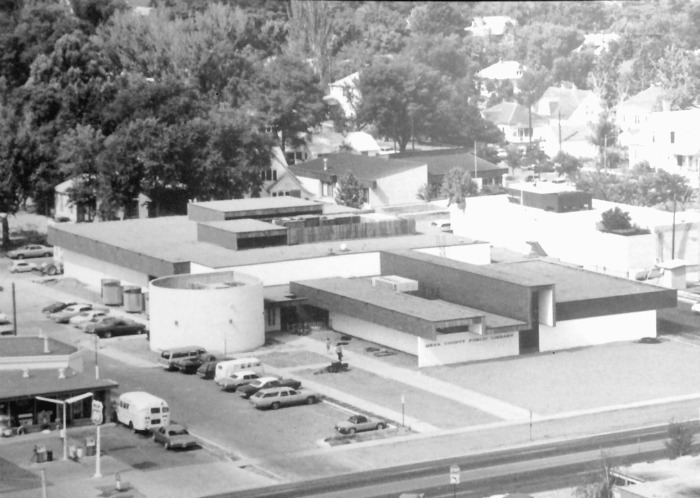
Mesa County Public Library moves to the corner of 5th and Grand in 1974
The 1.5 mill levy cap and the economic fortunes of Mesa County did not allow for continued expansion of services between 1974 and 1990. As funding for staff positions eroded, the hours open also declined. Even so, some progress was made. The Fruita Branch moved into the old museum location at 432 East Aspen Avenue in the mid-1970s, a new bookmobile was purchased with revenue sharing funds in 1981, and an all-volunteer-run branch opened in Gateway’s new community center in 1982.
The De Beque Branch moved into the newly built Town Hall in 1984, with De Beque’s town clerk also serving as librarian. In 1989, MCPL deemed this personnel arrangement insufficient for the library’s needs and closed the branch.
In 1989, after years of discussion about the need for a new branch building for Clifton, MCPL leased space in the Mesa Pointe Shopping Center and the new library opened in September of that year.
Aside from new branch accommodations, the most important addition during these years was the MARMOT online integrated computer system. MARMOT was an offshoot of Pathfinder, an early consortium of Western Colorado libraries. With MARMOT’s online launch in 1987, the library was able to provide users with an efficient system for library circulation and expanded access to the holdings of libraries throughout Colorado. The Central Library received computers initially; then computers were purchased for Clifton, Collbran, and Fruita in February 1989 and for other branches in the months following.
1990-1999
When MARMOT and Pathfinder parted ways in 1990, MCPL director Linda O’Connell took a one year leave of absence in order to assume the leadership of MARMOT and stabilize the organization. During this time and in the years following, MARMOT continued to expand its presence throughout MCPL and the Western Slope.
In 1990, the MCPL Board of Trustees appealed to county voters to increase the mill levy cap to 3 mills. Voters responded by approving the initiative, and 1991 became a banner year for the library. Staff was hired, hours restored, the materials budget increased, and significant capital improvements were made.
While all these improvements were underway in 1991, the Board of Trustees was engaged in a series of meetings with the county commissioners. It was becoming clear that the county, faced with providing mandated services, might not be able to continue to support the library if it remained a county department. As a result, the library board petitioned the commissioners to form the Mesa County Public Library District (MCPLD). The district became a legal entity on January 1, 1992.
The next challenge the library faced came in the form of a tax limitation amendment, known as the TABOR amendment, passed by Colorado voters in 1992. By 1997, it was clear the library would face financial hardship if the electorate did not provide relief from the restrictions of TABOR. An election was held in November 1997, at which time the voters of Mesa County authorized a levy of 3 mills for the library, with no limitation on the amount the 3 mills would provide, as well as an exemption from the limits from non-tax revenue sources.
These changes in revenue and governance allowed MCPLD to continue improving branch and outreach services.
By 1991, MCPLD needed to move the Collbran Branch to a new location but lacked viable options for such a move. Reluctantly, MCPLD considered ending library services in Collbran altogether. In response (and with MCPLD’s encouragement), the Plateau Valley Friends of the Library incorporated and raised funds to purchase and renovate the old Stockman’s Bank building on Main Street. The purchase and renovation were completed in short order, and the new Collbran Branch grand opening was July 4, 1991. The front of this historic building was restored thanks to a Historical Society Grant in 1995.
After three years without a public library in De Beque, the De Beque School District approached MCPLD in 1992 and offered to run a shared library. MCPLD enthusiastically agreed, and the De Beque Branch officially reopened on the site of the De Beque Elementary School on January 20, 1993. The De Beque Branch continues to operate from school grounds after moving into the new De Beque School building in 2017.
Seeing the need for a community center in Orchard Mesa, the Mesa County Valley School District approached MCPLD about opening a jointly-run branch library inside the Orchard Mesa Middle School building, which also housed a public pool. The two agencies went forward with the plan, and the Orchard Mesa Branch celebrated its grand opening on August 29, 1994.
Also in 1994, the City of Fruita appealed to MCPLD to have the Fruita Branch moved to the Fruita Natural History Center. MCPLD agreed to partner with the City of Fruita, and with the receipt of a Library Services and Construction Act grant, the parties were able to renovate a space on the second floor of the Civic Center building. The 1800 square-foot library opened in 1996.
The Clifton Branch Library moved across the street to the Peach Tree Shopping Center in 1998.
The library’s Homebound Service, now called Words on Wheels, began in 1999.
2000-2009
With a secure financial base, the Board of Trustees began an ambitious campaign in 1998 to construct a new Central Library in downtown Grand Junction. In 2001, the first-ever library capital campaign was created with the goal of raising $2.5 million. Over the next three years, $3 million was raised and used to purchase the property surrounding the library, including 443 North 6th Street, 550 Grand Avenue, and 536 Ouray Avenue. The library began using these properties for administrative offices, technical services, and meeting spaces. The library was on the ballot in 2003 and 2004, and both times narrowly lost ballot initiatives that would have generated bond money for a new Central Library at its current 5th and Grand location.
Meanwhile, three of the branches moved to new facilities. The Clifton Branch returned to the Mesa Pointe Shopping Center in 2011 (but to a different space), and the Orchard Mesa Branch moved to where it presently resides on Lynwood Street in 2010.
In 2001, The Town of Palisade asked the library to move out of the Palisade municipal building to allow the town government to expand its offices. The Palisade Branch moved into the old Palisade High School building in 2001 and ended oversight and involvement from the Town of Palisade in branch operation. The Palisade Branch operated on a lease of $10 a year from School District 51. In 2008, the Town of Palisade purchased the old Palisade High School complex and renovated the library’s space in the building.
A plan to remodel the Central Library launched in early 2005. Construction on the remodel project began in April of 2006 and included an enhanced entry and vestibule, a larger literacy center, a 21st-century computer lab, a teen area, program space, and a Western History room.
Also in 2006, Mesa County Public Library District updated its logo through a rebranding effort and shortened its name to Mesa County Libraries (MCL).
2010-2019
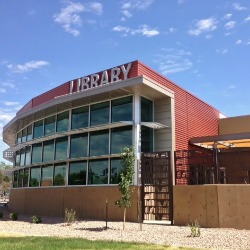
Current Central Library on the corner of 5th and Grand
Mesa County Libraries joined the Prospector library consortium in 2011, allowing patrons to order and receive books in relatively short order from libraries statewide. Also in 2011, Mesa County Libraries began circulating ebooks and eaudio books.
Construction for the Central Library Expansion Project began in August 2012 and finished in June 2013. The project added approximately 9,000 square feet of space to the building and improved the existing facility from top to bottom. Features added include more natural light inside, a new fiction area, a new Regional History Room, a large community room for programs and events, several new small-group study rooms, and outdoor patios for adults and children.
In 2008, the City of Fruita requested the participation of Mesa County Libraries on a committee to plan a new community center with the idea that the library would have a new branch location within the center. To build and operate the center, Fruita requested a 1% sales tax hike on the ballot on April 1, 2008. Although the ballot measure failed, it was by a narrow margin. The sales tax increase was again put to a vote in November 2008 and was passed by the citizens of Fruita. The Fruita Branch Library celebrated its grand opening in the new Fruita Community Center on February 12, 2011.
The Town of Palisade purchased the old Palisade High School building and grounds in 2008, with an eye toward creating a community center which would include several civic amenities, including a new library. The library was to be constructed with funds from both the Town of Palisade and Mesa County Libraries. When an application for state grant funding was turned down, the town was unable to contribute funds to the library’s construction. In 2011, MCL purchased the storefront property at 119 West Third Street. The Palisade Branch library celebrated its grand opening in that location on October 6, 2011.
In 2016, the 970West Studio opened at Fifth and Ouray, across the street from the Central Library. By planning and constructing the Studio, MCL acknowledged the expanding role of public libraries as both producers and providers of content. The construction cost of the Studio was $1,350,000, with most of that amount coming from cash reserves along with $250,000 from the Mesa County Public Library Foundation. The Studio provides use of recording equipment to community members at no cost, allowing the creation of unique, valuable content of local importance. It offers a variety of classes, hosts a rotating artist-in-residence, and is already well-used by the community.
2020 to Present Day
In the fall of 2023, the new Clifton Branch opened up at 3270 D 1/2 Rd. The new 17,800 square foot building is fully accessible and includes the Adult Learning Center with three small study rooms, a computer lab, and two classrooms dedicated for GED, English Language, and citizenship classes. There are also two large community rooms as well as many smaller study rooms.
*Some Information for this history was taken from the article:
Mackendrick, Donald A. “Splendid Public Temples: The Development of Libraries in Mesa County, Colorado 1892-1997.” Journal of the Western Slope. Vol 12, No. 2, Spring 1997, pp. 1-14.
